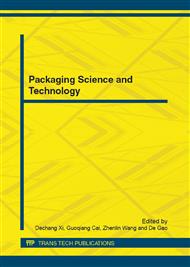p.80
p.86
p.90
p.94
p.98
p.104
p.109
p.114
p.118
A New Method for Constructing Damage Boundary Curve Using Shock Response Spectra
Abstract:
The theory and methods of damage boundary curve (DBC) based on input excitation accelerations have played important role in transportation packaging designs for commodities. However, in many cases the designed cushion pads according to the concept of traditional DBC can transmit a higher acceleration than the maximum critical acceleration and yet still not cause any damage to the products. That means the conservatism exist in the traditional theory and method, which would bring over package and result in the rise of transport cost and more wastes of packaging materials. Thus, constructing new DBC are necessary in cushioning packaging designs of commercial products. In this paper, we developed a new drawing method and procedure for constructing new DBC based on response accelerations and Biot Model which is different from traditional DBC based on excitation ones. The new DBC is beneficial to overcome the conversation brought by the traditional DBC in transport packaging design, and it may have a wider application in transport packaging design for commodities.
Info:
Periodical:
Pages:
98-103
Citation:
Online since:
October 2012
Authors:
Keywords:
Price:
Сopyright:
© 2012 Trans Tech Publications Ltd. All Rights Reserved
Share:
Citation:


